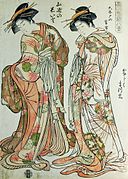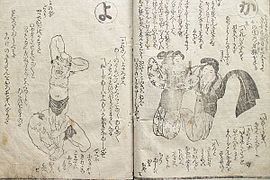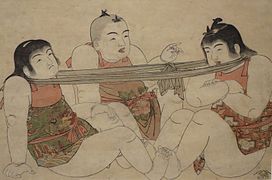Kitao Shigemasa
Kitao Shigemasa ( Japanese 北 尾 重 政 , actually Kitabatake Sasuke ( 北 畠 佐 助 ); first name Kyūgorō ( 九五 郎 ); born 1739 in Edo ; died March 8, 1820 ) was a Japanese master of the 17th and early 18th centuries Japanese color woodblock print .
He also signed as Heikisui ( 壁 水 ), Hokuhō ( 北 峰 ), Hokusu Dempu ( 北 鄒 田 夫 ), Ichiyōsei ( 一 陽 井 ), Itsujin ( 逸 人 ), Karan ( 花 藍 ), Kōsuifu ( 恒 酔 夫 ), Kōsuiken (Kōsuiken) 紅 翠 軒 ), Kōsuisai ( 紅 翠 斎 ), Kyūkaikyo ( 弓 巍 居 ), Shigureoka Itsumin ( 時 雨 岡 逸民 ), Suihō ( 酸 放 ), Tairei ( 台 嶺 ). Shigemasa, who was also a poet, founded the Kitao lineage of Ukiyo-e as a committed teacher.
life and work
Kitao was the eldest son of the bookseller Suhara Saburobei in the Kodemma-chō district in Edo , today's Tokyo . But he left the succession to his younger brother and decided to become an artist of the color woodcut. He seems to have taught himself how to make prints, probably in the later years of the Horeki period (1751–1764).
One of his best works is a set of unsigned prints in Ōban format (37 × 25 cm) that were published under the series title “Beautiful women in the east, west, south and north” ( 東西 南北 美人 , Tōzainamboku bijin ). But the main activity seems to have been the production of illustrations for books, for Kibyōshi or other types of books with stories or for illustrated books. He was a close friend of the ukiyoe artist Katsukawa Shunshō , with whom he worked. Examples are the set of twelve large prints entitled “ Raising Silkworms” ( 蚕 養 い 草 , Kaiko yashinai-gusa ) and the illustrated book with beautiful women ( 青楼 美人 合 わ せ て 姿 鏡 , Seirō bijin awase sugata kagami ), published in 1776 and that shows the life of courtesans.
Shigemasa, who was an excellent technician and eminent calligrapher, trained a number of students, including Kitao Masanobu ( 北 尾 政 信 ; 1761-1816), better known as Santō Kyōden , Kitao Masayoshi ( 北 尾 政 美 ; 1764-1824), too known under the name Kuwagata Keisai ( 鍬 形 恵 斎 ; 1764-1824) and Kubo Shumman ( 窪 俊 満 ; 1757-1820). He also had a huge impact on younger artists such as Torii Kiyonaga and Kitagawa Utamaro .
photos
Playful hiragana characters
Remarks
- ↑ Kibyōshi ( 黄 表 紙 ) were, as the name suggests, booklets with a yellow cover that contained a certain type of story.
- ↑ Seirō, literally "green houses", is the description for a prostitute quarter in the Edo period.
Individual evidence
literature
- Inagaki, Shin'ichi: Kitao Shigemasa. In: Ukiyoe Nyūmon. Kawade, 1990. ISBN 4-309-72476-0 .
- Tazawa, Yutaka: Kitao Shigemasa . In: Biographical Dictionary of Japanese Art. Kodansha International, 1981. ISBN 0-87011-488-3 .
- Laurance P. Roberts: Kitao Shigemasa . In: A Dictionary of Japanese Artists. Weatherhill, 1976. ISBN 0-8348-0113-2 .
Web links
| personal data | |
|---|---|
| SURNAME | Kitao, Shigemasa |
| ALTERNATIVE NAMES | 北 尾 重 政 (Japanese, stage name); Kitabatake Sasuke (real name); 北 畠 佐 助 (Japanese, real name) |
| BRIEF DESCRIPTION | Japanese painter |
| DATE OF BIRTH | 1739 |
| PLACE OF BIRTH | Edo |
| DATE OF DEATH | March 8, 1820 |





